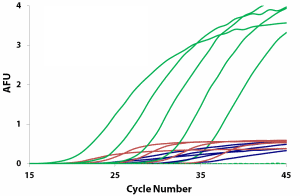Content #1
Content #1
Content #1
Although many advances have been made in the design of PCR-based diagnostic devices, a major limiting step is sample preparation. Some samples, such as whole blood, contain PCR inhibitors that need to be removed; this is conventionally done by a multistep process using solid phase extraction to capture and then wash DNA after sample lysis.
In an article in the March 2017 issue of Analytical Chemistry, Nanayakkara and colleagues reported a simplified method to purify and amplify DNA from whole blood and other complex samples. Magnetic silica microparticles covalently functionalized with chitosan were shown to capture DNA from human cells and whole blood by mechanical agitation in lysis buffer. After a single washing step, the microparticles, with DNA still bound, were added to a PCR reaction. Quantitative PCR was performed, using EvaGreen® qPCR dye for signal enhancement. Magnets were placed next to the PCR reactions during thermocycling to sequester the microparticles to prevent interference with the fluorescence measurements. The authors demonstrated the sensitivity of this approach by successfully amplifying human genomic DNA sequences from a ∼1 μL droplet of whole blood.
The authors hope that this streamlined method for preparing DNA for PCR amplification will help to expand nucleic acid diagnostic assays, especially for near-patient applications.
To read the original article, click here.
Nanayakkara IA, Cao W, White IM. Simplifying Nucleic Acid Amplification from Whole Blood with Direct Polymerase Chain Reaction on Chitosan Microparticles. Analytical Chemistry. 2017. doi: 10.1021/acs.analchem.7b00274.

To learn more about the safe and sensitive qPCR dye EvaGreen, click here.